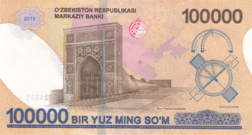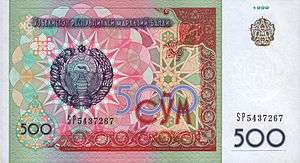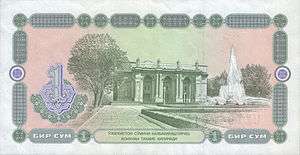Uzbekistani soʻm
The soʻm (Uzbek: soʻm in Latin script, сўм in Cyrillic script) is the currency of Uzbekistan in Central Asia.
- For earlier currencies used in Uzbekistan, see Bukharan tenga, Kokand tenga and Khwarazmi tenga.
| Uzbekistani soʻm | |
|---|---|
| Oʻzbek soʻmi / Ўзбек сўми (in Uzbek) | |
 100,000 soʻm. | |
| ISO 4217 | |
| Code | UZS |
| Denominations | |
| Subunit | |
| 1/100 | Tiyin |
| Plural | The language(s) of this currency do(es) not have a morphological plural distinction. |
| Banknotes | |
| Freq. used | 1000, 5000, 10,000, 50,000, 100,000 soʻm |
| Rarely used | 200, 500 soʻm |
| Coins | |
| Freq. used | 50, 100, 200, 500 soʻm |
| Rarely used | 1, 3, 5, 10, 20, 50 tiyin, 1, 5, 10, 25 soʻm |
| Demographics | |
| User(s) | |
| Issuance | |
| Central bank | Central Bank of the Republic of Uzbekistan (O'zbekiston Respublikasi Markaziy Banki) |
| Website | www.cbu.uz |
| Valuation | |
| Inflation | 8.5% |
| Source | , 2015 est. |
Etymology
In the Soviet Union, speakers of Kazakh, Kyrgyz and Uzbek called the ruble the som, and this name appeared written on the back of banknotes, among the texts for the value of the bill in all 15 official languages of the Union. The word som (sometimes transliterated "sum" or "soum") means "pure" in Kyrgyz, Uyghur and Uzbek, as well as in many other Turkic languages. The word implies "pure gold".
First soʻm
History
Like other republics of the former Soviet Union, Uzbekistan continued using the Soviet/Russian ruble after independence. On 26 July 1993, a new series of Russian ruble was issued and the old Soviet/Russian ruble ceased to be legal tender in Russia.[1][2] Some successor states had their national currencies before the change, some chose to continue using the pre-1993 Soviet/Russian ruble, and some chose to use both the pre-1993 and the new Russian ruble. Tables of modern monetary history: Asia[3] implies that both old and new rubles were used in Uzbekistan.
Uzbekistan replaced the ruble with soʻm at par in on November 15, 1993.[3] No subdivisions of this som were issued and only banknotes were produced, in denominations of 1, 3, 5, 10, 25, 50, 100, 200, 500, 1000, 5000, and 10,000 soʻm. Because it was meant to be a transitional currency, the design was rather simplistic. All notes had the Coat of arms on obverse, and Sher-Dor Madrasah of the Registan in Samarkand on reverse.
Coins
No coins were issued for the first soʻm.
Banknotes
The first banknotes were issued by the State Bank of Uzbekistan in 1993. All of the denominations share the same designs: the Coat of arms of Uzbekistan on the front and the madrasahs on Registan Square in Samarkand.
Second soʻm
History

On 1 July 1994,[3] a second som was introduced at a rate of 1 new soʻm = 1000 old soʻm. This soʻm is subdivided into 100 tiyin.
Inflation
Until 2013, the largest denomination of Uzbek currency was the 1,000 soʻm banknote, then worth US$0.60, requiring Uzbeks to carry large amounts of notes just to carry out grocery shopping and bill payment.
Since 2019, the largest denomination is the 100,000 soʻm banknote (as of October 2019 worth US$10.55), which made the situation easier. The smallest denomination, the 1 tiyin, is worth less than 1⁄9400 of a U.S. cent making it the "world's most worthless coin" that is still legal tender. However, coins and banknotes smaller than 50 soʻm are rare now.[4]
The rampant inflation situation is considered a politically sensitive issue in Uzbekistan, which is why the Uzbek government is slow to acclimate the currency to its current value by issuing higher coin and note denominations. As a result, the current highest coin denomination in circulation is the 500 soʻm while the highest banknote denomination is the 100,000 soʻm. Official state figures put inflation as of the first half of 2011 at 3.6%, however accurate numbers are pinned far higher. Coins and banknotes below 25 soʻm are practically worthless now.
Coins
3 series of coins have been issued for the second soʻm. They can be easily distinguished by the script used for the Uzbek language. The first series was written in Cyrillic script, while the second and third series is written in Latin script.
| First Series | ||||||
|---|---|---|---|---|---|---|
| Image | Value | Composition | Description | Date of minting | ||
| Obverse | Reverse | Obverse | Reverse | |||
| 1 tiyin | Brass-clad steel | Coat of arms with 12 stars State title |
Value, year of minting | 1994 | ||
| 3 tiyin | ||||||
| 5 tiyin | ||||||
| 10 tiyin | Nickel-clad steel | Coat of arms with 12 stars State title |
Value, year of minting | 1994 | ||
| 20 tiyin | ||||||
| 50 tiyin | ||||||
| 1 soʻm | 1997, 1998, 1999 | |||||
| 5 soʻm | 1997, 1998, 1999 | |||||
| 10 soʻm | 1997, 1998, 1999, 2000 | |||||
| For table standards, see the coin specification table. | ||||||
| Second Series | ||||||||
|---|---|---|---|---|---|---|---|---|
| Image | Value | Technical parameters | Description | Date of minting | ||||
| Diameter | Mass | Composition | Edge | Obverse | Reverse | |||
 |
1 soʻm | 18.4 mm | 2.83 g | Stainless steel | Reeded | Coat of arms without stars Bank title, year of minting |
Value, map of Uzbekistan | 2000 |
| 5 soʻm | 21.2 mm | 3.35 g | Brass-clad steel | Plain | Coat of arms without stars Bank title, year of minting |
Value, map of Uzbekistan | 2001 | |
.jpg) |
10 soʻm | 19.75 mm | 2.71 g | Nickel-clad steel | Plain | Coat of arms without stars Bank title, year of minting |
Value, map of Uzbekistan | 2001 |
 |
25 soʻm | 27 mm | Coat of arms without stars State title, year of minting |
Value, Jalal ad-Din Mingburnu | 1999 | |||
 |
50 soʻm | 26.1 mm | 8 g | Plain and reeded sections | Coat of arms without stars Bank title, year of minting |
Value, map of Uzbekistan | 20011 | |
| 50 soʻm | 26.1 mm | 7.9 g | Value, statue and ruin of Shahrisabz | 20022 | ||||
 |
100 soʻm | 26.9 mm | 7.9 g | Nickel-plated steel | Inscription | Coat of arms without stars Bank title, year of minting |
Value, map of Uzbekistan, sunrays | 20043 |
| These images are to scale at 2.5 pixels per millimetre. For table standards, see the coin specification table. | ||||||||
Third series (2018)
In May 2018 the introduction of new coins valued 50, 100, 200 and 500 soʻm was announced. All previously issued banknotes and coins of those denominations are to be withdrawn from circulation by July 2020.
| Third series (2018)[5] | |||||||||||||||
|---|---|---|---|---|---|---|---|---|---|---|---|---|---|---|---|
| Image | Value | Technical parameters | Description | Date of | |||||||||||
| Diameter | Mass | Composition | Edge | Obverse | Reverse | minting | issue | withdrawal | lapse | ||||||
 |
50 soʻm | 18.0 mm | 2.0g | Nickel-plated steel | Plain | Denomination | National emblem of Uzbekistan, year of minting | 2018 | 2 July 2018[6] | Current | |||||
 |
100 soʻm | 20.0 mm | 2.5 g | Independence and Goodness monument, Tashkent | |||||||||||
 |
200 soʻm | 22.0 mm | 3.3 g | Detail of a tiger mosaiс on the Sher-Dor Madrasah at the Registan in Samarkand | |||||||||||
 |
500 soʻm | 24.0 mm | 3.9 g | Palace of Conventions (Anjumanlar Saroyi) in Tashkent | |||||||||||
| These images are to scale at 2.5 pixels per millimetre. For table standards, see the coin specification table. | |||||||||||||||
Banknotes
The second and current series, issued by the Central Bank of the Republic of Uzbekistan, was released in 1994 in denominations of 1, 3, 5, 10, 25, 50, and 100 soʻm. A 200 soʻm banknote was issued in 1997, the 500 soʻm in 1999, the 1,000 soʻm in 2001, the 5,000 soʻm in 2013, the 10,000 soʻm on 10 March 2017, the 50,000 soʻm on 22 August 2017 and the 100,000 soʻm on 25 February 2019. The latter four denominations feature inscriptions in Latin-based Uzbek as opposed to Uzbek Cyrillic in banknotes of 1 to 1,000 Uzbek soʻm.
| 1994-2017 Series[7] | ||||||||
|---|---|---|---|---|---|---|---|---|
| Image | Value | Main Colour | Description | Date of printing | Date of first issue | withdrawal | ||
| Obverse | Reverse | Obverse | Reverse | |||||
 |
 |
1 soʻm | Green and pink | National emblem of Uzbekistan | Alisher Navoi Opera and Ballet Theater in Tashkent | 1994 | 1 July 1994 | 1 January 2021 |
 |
 |
3 soʻm | Red | Chashma-Ayub Mausoleum in Bukhara | ||||
 |
 |
5 soʻm | Blue and orange | National emblem of Uzbekistan and Islamic pattern | Alisher Navoi Monument in Tashkent | |||
 |
 |
10 soʻm | Purple | Gur-e Amir in Samarkand | ||||
 |
 |
25 soʻm | Blue and pink | Shah-i-Zinda Complex in Samarkand | ||||
 |
 |
50 soʻm | Brown | The three Madrasahs of the Registan in Samarkand | 1 July 2019[8] | |||
 |
 |
100 soʻm | Purple | Palace of Friendship of Peoples in Tashkent | ||||
 |
 |
200 soʻm | Green | National emblem of Uzbekistan | Detail of a tiger mosaiс (Shir o Khorshid) on the Sherdor Madrasah at the Registan in Samarkand | 1997 | 1 March 1997[9] | 1 July 2020[8] |
 |
 |
500 soʻm | Red and some green | Statue of Amir Temur (Tamerlane) in Tashkent | 1999 | 1 June 2000[10] | ||
 |
 |
1,000 soʻm | Grey | Amir Timur Museum in Tashkent | 2001 | 1 September 2001[11] | Current | |
 |
 |
5,000 soʻm | Green | National Assembly (Oliy Majlis) in Tashkent | 2013 | 1 July 2013 | ||
_obvers.jpg) |
_reverse.jpg) |
10,000 soʻm | Blue | Senate (Senat) in Tashkent | 2017 | 10 March 2017 | ||
_obverse.jpg) |
_reverse.jpg) |
50,000 soʻm | Violet | National emblem of Uzbekistan; top of the “Ezgulik” ark in Independence Square in Tashkent | Palace of Conventions (Anjumanlar Saroyi) in Tashkent | 22 August 2017 | ||
 |
 |
100,000 soʻm | Orange and light brown | National emblem of Uzbekistan; Mirzo Ulugbek; solar system | Mirzo Ulugbek Observatory in Samarkand; map of Uzbekistan | 2019 | 25 February 2019 | |
| For table standards, see the banknote specification table. | ||||||||
Exchange rates
At its introduction on 1 July 1994, 1 U.S. dollar was equal to 25 soʻm.
2017 reform
On 2 September 2017, President of Uzbekistan Shavkat Mirziyoyev issued a decree "On priority measures of liberalizing foreign exchange policy".[12] The reform took effect on 5 September 2017. The currency was untethered from its US dollar peg and started to float. As a result the soʻm's exchange rate to the US dollar increased from 4,210 Uzbek soʻm to 8,100 Uzbek soʻm. The new rate was even weaker than the soʻm's black-market convertibility of about 7,700 to the dollar. Restrictions on the amount of foreign currencies individuals and companies could buy were also abolished on the same day.[13]
| Current UZS exchange rates | |
|---|---|
| From Google Finance: | AUD CAD CHF EUR GBP HKD JPY USD RUB CNY |
| From Yahoo! Finance: | AUD CAD CHF EUR GBP HKD JPY USD RUB CNY |
| From XE.com: | AUD CAD CHF EUR GBP HKD JPY USD RUB CNY |
| From OANDA: | AUD CAD CHF EUR GBP HKD JPY USD RUB CNY |
| From fxtop.com: | AUD CAD CHF EUR GBP HKD JPY USD RUB CNY |
See also
Notes
- "The Global History of Currencies - Russia". Archived from the original on 4 January 2007. Retrieved 12 November 2017.
- U.S. Department of State (February 1994). "Uzbekistan Economic Policy and Trade Practices". Archived from the original on 2010-07-10. Retrieved 19 September 2015.
- Schuler, Kurt. "Tables of Modern Monetary History: Asia".
- Gray, Laura (26 February 2013). "The most worthless coin in the world". Retrieved 12 November 2017 – via www.bbc.com.
- "Монеты". www.cbu.uz.
- "СО 2 ИЮЛЯ 2018 ГОДА ВВОДЯТСЯ НОВЫЕ МОНЕТЫ В 50, 100, 200 И 500 СУМОВ". www.norma.uz. 28 June 2018.
- "banknotes". Retrieved 12 November 2017.
- "Центральный банк Республики Узбекистан — Сообщение Центрального банка Республики Узбекистан" (in Russian). cbu.uz. Retrieved 2018-05-26.
- "Узбекскому суму исполнилось 20 лет" (in Russian). gazeta.uz. Retrieved 2019-01-05.
- "Узбекскому суму исполнилось 20 лет" (in Russian). gazeta.uz. Retrieved 2019-01-05.
- "Узбекскому суму исполнилось 20 лет" (in Russian). gazeta.uz. Retrieved 2019-01-05.
- The Government portal of the Republic of Uzbekistan (2017-09-05). "Starting from 5 September 2017, the exchange rate of the Central Bank is set at 8100 UZS for 1 USD". Retrieved 8 September 2017.
- Radio Free Europe/Radio Liberty (2017-09-05). "Uzbekistan Devalues Currency As It Emerges From Decades-Long Isolation". Retrieved 8 September 2017.
References
- Krause, Chester L.; Clifford Mishler (2003). 2004 Standard Catalog of World Coins: 1901–Present. Colin R. Bruce II (senior editor) (31st ed.). Krause Publications. ISBN 0873495934.
- Cuhaj, George S. (editor) (2005). Standard Catalog of World Paper Money: Modern Issues 1961-Date (11th ed.). Krause Publications. ISBN 0-89689-160-7.CS1 maint: extra text: authors list (link)